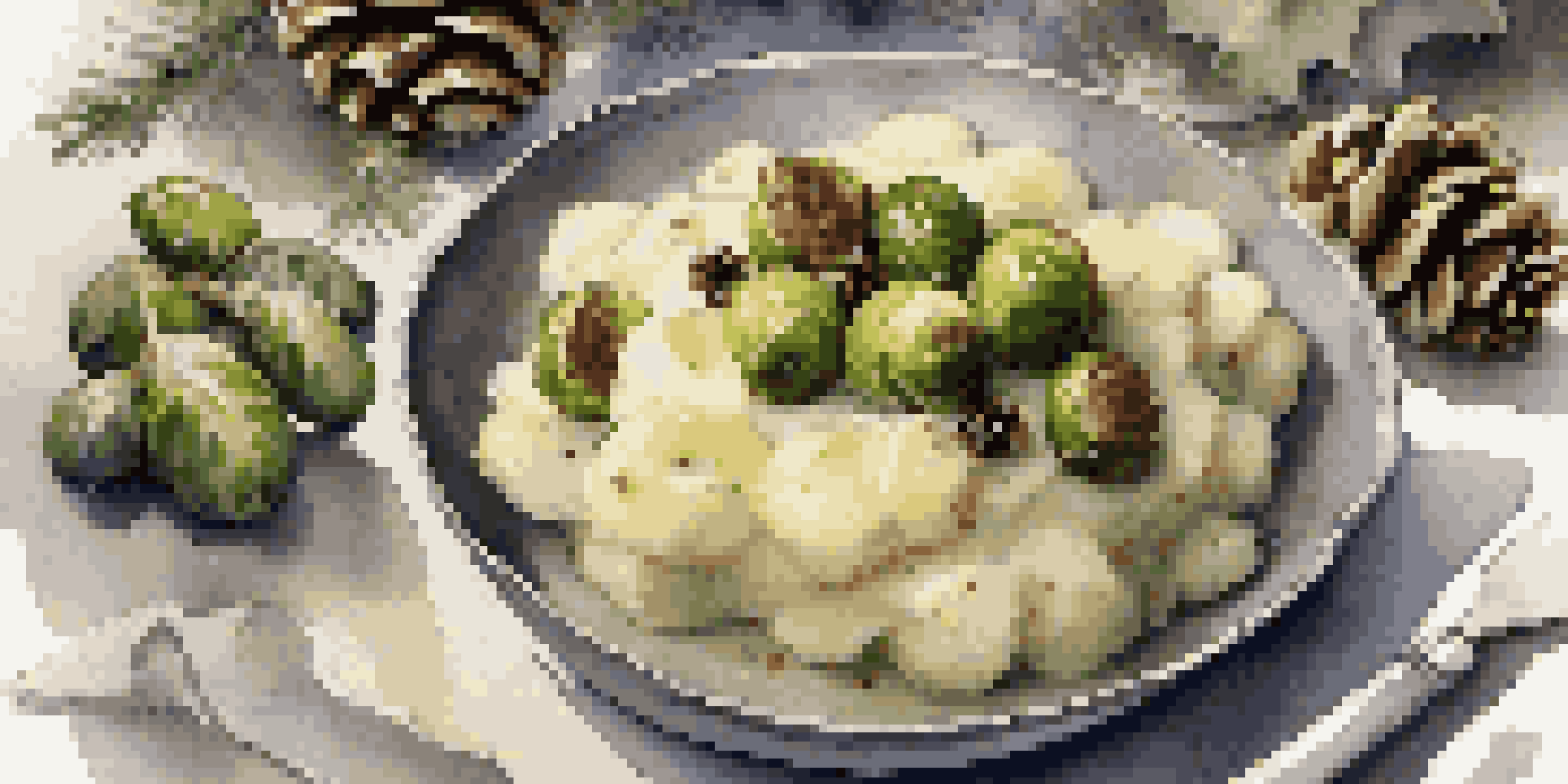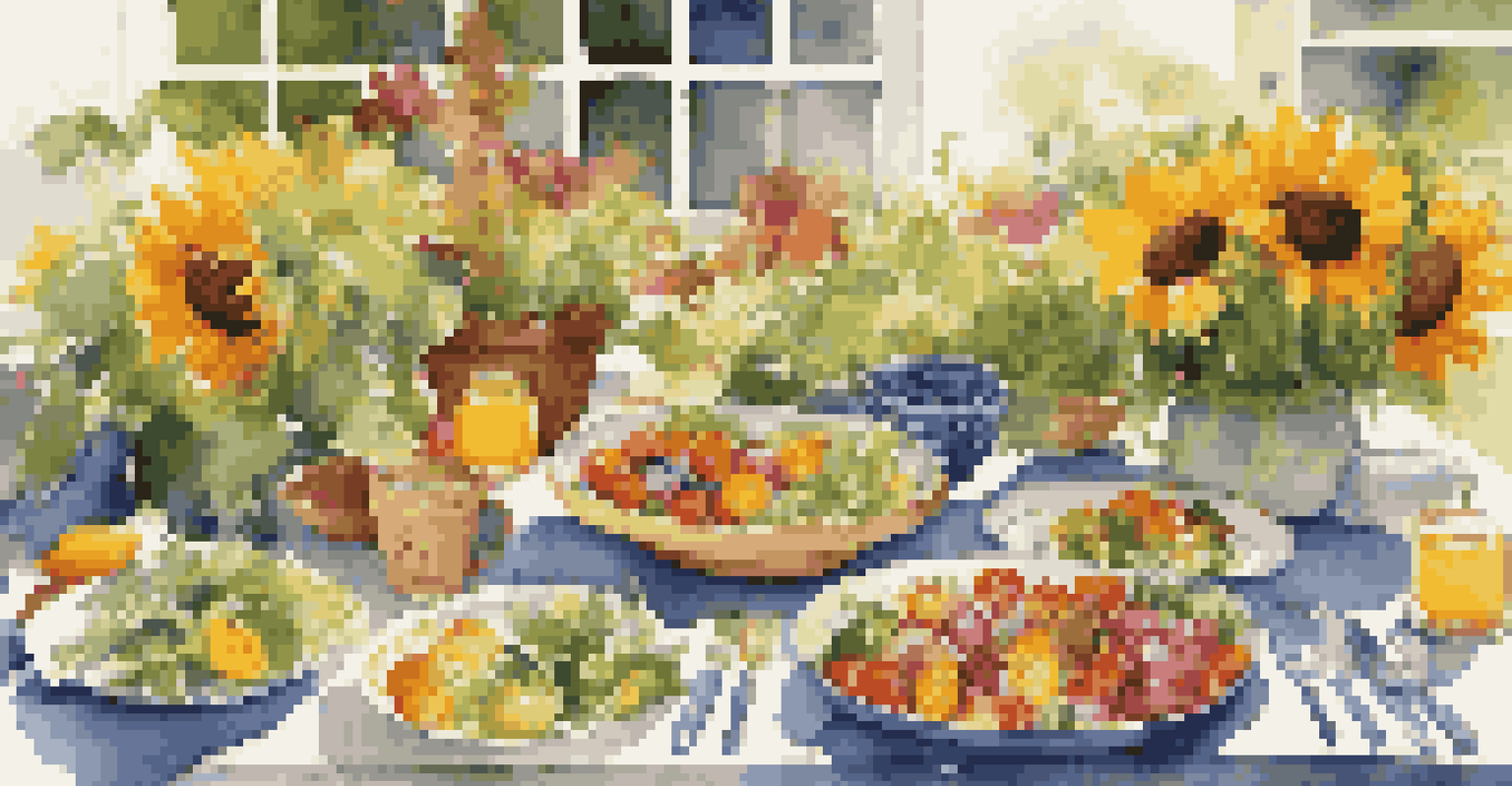Seasonal Themes in Culinary Presentation: Celebrating Nature

Understanding the Importance of Seasonal Ingredients
Seasonal ingredients are at the heart of culinary presentations. They not only provide freshness but also contribute to vibrant colors and flavors that reflect the time of year. For instance, using ripe tomatoes in summer dishes adds a burst of taste that’s hard to replicate with out-of-season produce.
Eating seasonally is not just about what you eat, but about how you eat and how you connect with the land.
Embracing seasonal ingredients means you’re also supporting local farmers and reducing your carbon footprint. When you choose what’s in season, you’re opting for sustainability, which is increasingly important in our modern world. This connection to local agriculture can also deepen your appreciation for the food you prepare.
Incorporating seasonal ingredients into your dishes can also spark creativity in the kitchen. Think of how a simple pumpkin can be transformed into a comforting soup in fall or a zesty salad in spring. The changing seasons offer a canvas for chefs to express their culinary artistry.
Color Palettes Inspired by Nature’s Seasons
The colors of nature provide an endless palette for culinary presentations. In spring, think pastels and bright greens, while autumn invites rich oranges, deep reds, and earthy browns. These colors not only enhance visual appeal but also evoke emotions tied to the seasons, making your dishes more inviting.

Creating a visually stunning plate involves balancing colors just as an artist would on a canvas. A dish featuring grilled asparagus drizzled with a golden lemon sauce not only looks appealing but also signifies the freshness of spring. The right color combination can make your meal feel more seasonal and vibrant.
Embrace Seasonal Ingredients
Using seasonal ingredients not only enhances flavor and freshness but also supports local farmers and sustainability.
By paying attention to color, chefs can tell a seasonal story through their food. For example, a winter dish might feature creamy white mashed potatoes contrasted with deep green roasted Brussels sprouts, symbolizing the cozy yet colorful nature of the colder months. This attention to detail enhances the overall dining experience.
Textures as a Reflection of Seasonal Changes
Texture plays a significant role in culinary presentation and can reflect the changing seasons. In summer, light and crisp textures dominate, inviting refreshment and lightness, while winter calls for hearty and comforting elements. Imagine the crunch of fresh vegetables in a salad contrasted with the creaminess of a winter stew.
The best way to eat is to eat what is in season and what is local, because that's what tastes the best.
Combining various textures can elevate your dishes and create a more engaging eating experience. A bowl of fall-inspired roasted root vegetables can be paired with creamy feta cheese, offering a delightful contrast that excites the palate. This interplay between different textures keeps diners interested and satisfied.
By thoughtfully incorporating textures, chefs can mimic the natural world’s rhythm. The crunch of autumn apples, the smoothness of winter soups, or the fluffy nature of spring pastries all tell a story that resonates with the seasons, enhancing the connection between food and nature.
Incorporating Seasonal Themes into Menu Design
Menu design is an excellent opportunity to reflect seasonal themes in culinary presentation. By organizing dishes around seasonal motifs, you can guide diners through a journey of flavors that changes with the seasons. For instance, a summer menu might feature vibrant salads, grilled vegetables, and refreshing sorbets.
When crafting a seasonal menu, consider using descriptive language that highlights the essence of the ingredients. Words like 'harvested,' 'sun-ripened,' and 'freshly picked' can evoke images of nature and its bounty, enticing diners to try your creations. This not only markets your dishes effectively but also enhances the dining experience.
Enhance Dining with Color and Texture
Incorporating vibrant colors and varied textures in dishes creates a visually appealing and engaging dining experience.
Ultimately, a well-designed seasonal menu can set the tone for the entire dining experience. It invites guests to appreciate the changing landscape of food while exploring new flavors that align with the time of year. This immersive approach can turn a meal into a celebration of the seasons.
Table Decor that Echoes Seasonal Themes
Table decor is a powerful way to enhance the seasonal culinary experience. Using elements like fresh flowers, seasonal fruits, and themed tableware can create an atmosphere that complements your dishes. For example, a summer table might feature sunflowers and bright table linens, while autumn might bring in deep oranges and rustic wooden elements.
Incorporating natural elements into table decor not only beautifies the dining area but also reinforces the connection to nature that seasonal cooking embodies. Consider using pinecones in winter or fresh herbs in spring as part of your centerpiece. These small touches can create a cohesive theme that enhances the overall experience.
Moreover, the right decor can elevate the mood and encourage diners to immerse themselves in the seasonal theme. A beautifully set table that reflects the season's essence invites guests to slow down and savor their meal, turning an ordinary dinner into a memorable occasion.
Sustainable Practices in Seasonal Culinary Presentation
Sustainability is an essential aspect of celebrating seasonal themes in culinary presentation. Choosing local and organic ingredients reduces environmental impact and promotes biodiversity. By sourcing your produce from nearby farms, you not only support the local economy but also enjoy fresher and tastier ingredients.
Incorporating sustainable practices can also extend to your presentation methods. Using biodegradable or reusable serving ware, for instance, reflects a commitment to environmental responsibility while enhancing the visual appeal of your dishes. It's about making mindful choices that resonate with today's eco-conscious diners.
Celebrate Seasons with Culinary Events
Seasonal culinary events foster community while showcasing local ingredients and promoting sustainable practices.
By embracing sustainability in your culinary practices, you create a positive impact on both the environment and your community. As diners become more aware of the origins of their food, showcasing your sustainable efforts can be a unique selling point that resonates deeply with your audience.
Celebrating Seasonal Themes Through Culinary Events
Culinary events centered around seasonal themes can create memorable experiences that celebrate nature. From farm-to-table dinners to seasonal festivals, these gatherings offer an opportunity to showcase the best of what each season has to offer. They foster a sense of community and appreciation for local ingredients.
Organizing seasonal culinary events allows chefs to experiment with new dishes and presentation styles, creating excitement around the menu. A summer barbecue featuring fresh, grilled vegetables and seasonal fruits can become a highlight of the year, bringing people together to enjoy food in a lively atmosphere.

These events not only promote seasonal eating but also educate diners about the importance of sustainability and local sourcing. By sharing stories behind the ingredients and showcasing local farmers, chefs can create a deeper connection between diners and their food, celebrating the bounty of nature in every bite.